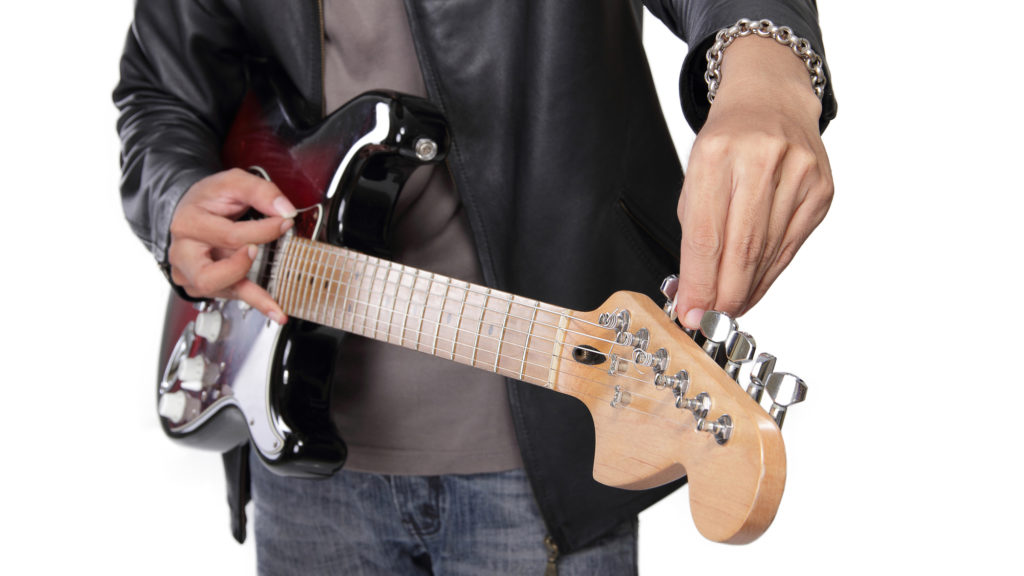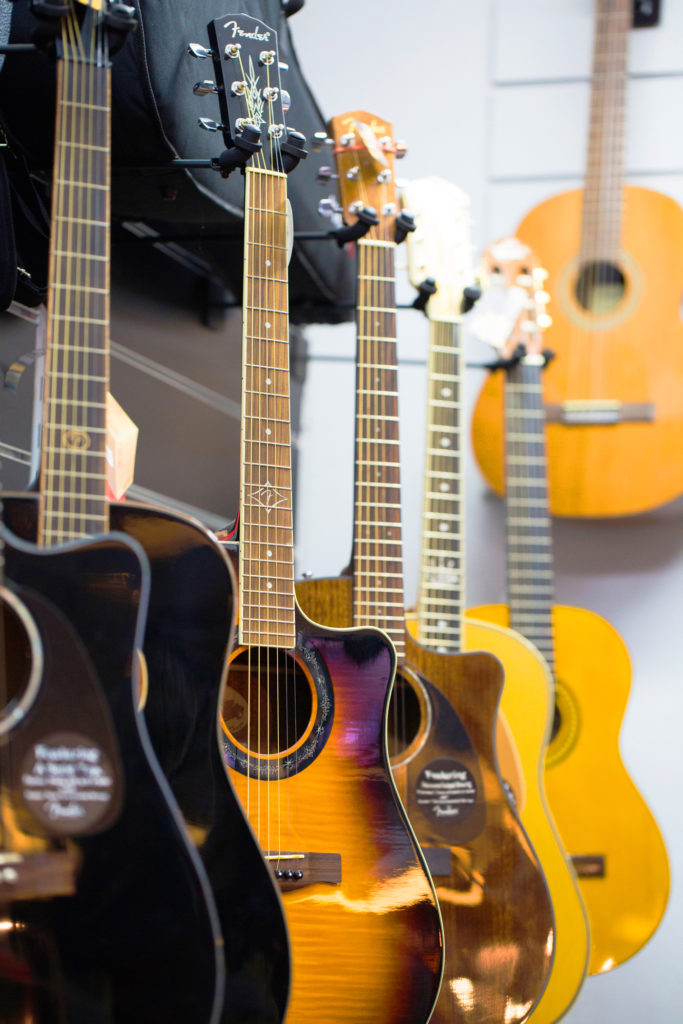
If you're new to the guitar, changing your strings can seem like a complicated process. However, it's a pretty straightforward task and, just like playing the guitar, it gets easier the more frequently you do it.
Since so many of our students ask us how to change guitar strings, we've decided to provide you with a comprehensive guide to all things guitar string-related, including types of guitar strings, why & how to change guitar strings, how to tune your newly strung guitar and finally how to make your guitar strings last longer.
Why Change Your Guitar Strings At All?
As the primary sound-making element of your instrument, your guitar strings need to be in good shape when you play.
There are a couple of reasons why you might want to change your strings:
- If a string breaks—Your guitar strings can break if you play roughly or mistune your guitar. Each string is designed for a certain tension and if you tighten one too much when tuning your guitar, it may snap.
- If your guitar is difficult to play—Old strings are harder to play because they're covered in finger grease and debris. New strings feel light and responsive, making it easier to change chord positions and play melodies.
- If your guitar sounds dull—This is up to personal taste, but most guitar players prefer the sound of bright, new strings. Old strings tend to make a dull, lackluster sound.
Note: Change all your strings at the same time. If one of your guitar strings breaks and you only replace that one, you'll notice that the new guitar string has a totally different sound than the rest. This makes it almost impossible to achieve a consistent sound.
Types of Guitars and The Strings They Use
There are three major types of guitars on the market, and each one uses different string materials to produce different sounds. When changing your strings, you want to be sure you pick the right guitar strings for your instrument:
- Electric guitars use strings made of either nickel or stainless steel. Since electric guitar pickups require magnets to transmit sound, the strings need to be made of a magnetic metal alloy.
- Acoustic guitars use strings made of bronze or brass, although steel strings for acoustic guitars also exist.
- Classical guitars use nylon strings. You can tell these apart because they are soft,flexible, and they produce a mellow, pure sound.
Classical guitars, electric guitars and acoustic guitars all feature different stringing mechanisms, so we'll cover each one in its own section.
How To Change the Strings on an Acoustic Guitar
Changing the strings on your acoustic guitar is a simple procedure.
First, you'll want to remove all the strings on your acoustic guitar by winding the tuning pegs located on the instrument's headstock until the strings can be easily removed. This is a good time to wipe down the instrument and clean the fretboard.

Next, you'll want to remove the acoustic guitar's bridge pins. These are small knob-headed components located on the guitar's body near its sound hole. Bridge pins are designed to fit snugly into the guitar's body, holding the string in place. For this reason, pulling them out might be difficult. Take your time and gently wedge them out—pliers can help but be careful not to force them or damage the guitar. Sometimes, debris gets stuck in the holes making it tough to pull out the pins. You can try to push the strings inwards into the hole which it sits in. This displaces the debris, thus making the process easier. This is the first thing you should try before prying the bridge pins out with pliers.

Now that the strings and bridge pins have been removed, your guitar is ready to be stringed. Open up your pack of strings and pay attention to the string gauges—the numbers that are printed on each individual string packet. Arrange them from thickest to thinnest so that you don't accidentally put on the wrong strings. In playing position, the thinnest string should be closest to the floor and the thickest string closest to the ceiling.
With your strings laid out, you can now attach the first string. Many guitarists prefer to alternate their stringing, attaching the thinnest string first and then the thickest string on the opposite of the fretboard, then the second-thinnest and so on. This helps keep tension relatively stable—an important factor for acoustic guitars.
You'll notice the string has one end with a circular knob on the end. Insert that knob into the bridge pin hole and then place the bridge pin over it. After that, stretch the string over the fretboard and thread the other end through the hole in its respective tuning peg. Leave a little bit of slack so that the string can tighten properly, and make a 90-degree bend in the string where it exits the tuning peg thread-hole so that it can't double back on itself.

With the tuning peg threaded, you're ready to tighten the string. Start turning the peg to the right and continue until the string winds its way around the peg and begins to tighten sufficiently to make sound. You'll probably spend a few minutes turning the pegs—a peg winding tool can be very helpful here. Observe the way the string winds around the peg and make sure it doesn't overlap, cross itself or interact with any other strings. The string should wind downwards, making a clear spiral as you tighten it.

For now, just get the string tight enough to hold on its own and make a sound when plucked. You'll tune the guitar once you have all the strings replaced. After repeating the process for the other strings, use wire cutters to snip off the excess string hanging off the headstock. If you don't have wire cutters, you can wrap the excess string around its peg.

How To Change the Strings on an Electric Guitar
Stringing the electric guitar is very similar to stringing an acoustic guitar—with the exception of bridge pins. Electric guitars do not have bridge pins, instead relying on a spring-and-screw mechanism that offers the guitarist the ability to change the height of each string relative to the fretboard—the string's "action."
Since there are no bridge pins to worry about, you can start by turning the tuning pegs to the left until you can remove the existing strings by threading them back through the electric guitar's bridgepiece. Different manufacturers have different mechanisms, but the underlying principle remains the same for each one.

Layout your strings, arranged in order of thickness, and begin by threading the empty end of the string through the bridgepiece, up across the fretboard and all the way to the tuning peg. Thread the end of the string through the hole in the tuning peg, leaving enough slack so that you can get a few full revolutions in, and begin winding. The string will gradually tighten until it sets into its course on the guitar and begins making a clear, consistent sound.
Just like the acoustic guitar, it's worthwhile to alternate your stringing so that the guitar's neck doesn't undergo too much tension in the process. Electric guitars tend to be more durable than acoustics, however, so keep in mind that this isn't a hard-and-fast rule.
How to Change Strings on a Classical Guitar
Classical guitars use an older mechanism for maintaining string tension. While the headstock-end of the guitar operates on a similar principle, the bridge has no bridge pins and no metal screw mechanism(saddles) for keeping the strings in place. Instead, you have to tie the string by hand.
First, remove the strings already on the guitar and layout your strings in order of thickness just as you would with an electric or acoustic guitar. Then, thread the string through the hole in the guitar's bridge piece going from the inside to the outside. Pull a few inches out and loop the string under its other half, then tuck it under the loop once. Hold the longer end of the string against the guitar and pull on the short end to tighten it to the bridge. This is your knot. Note that you might need to loop the thinner strings around more than once to get them to stick.
Now you're ready to thread the long end of the string into the headstock's tuning pegs. Turn the pegs until the holes are facing outward and then thread the string through. Pull the string towards the fretboard, reaching around and making another loop so that it stays tight. Now you're ready to turn the peg and tighten the string.
Tuning Your Newly Strung Guitar
Once you have all your strings changed, you're ready to tune your guitar. The best way to do this is using an electronic tuner, but if you have a good ear you can match each string to a note played on a piano or other instrument.
Note: The standard tuning for the six-string guitar is E-A-D-G-B-E, going from the thickest string to the thinnest.
You might find that your guitar doesn't immediately stay in tune, or that tuning some strings causes others to change pitch and jump out of tune. This is normal while strings are new.
Guitar strings are sensitive things. Different types of strings respond in different ways to being newly strung, and almost all of them need some time before they "set in" and stay in tune consistently. If you want to rush the process, you can gently pull the strings away from the fretboard so that they stretch fully, making them more likely to remain in tune. Stretch and retune atleast twice for every string to maintain a steady tuning. If you don't want to do this, your strings will set in after a day or two and you'll be able to tune and play properly without any issues.
You can read more about guitar tuning in our article on How to Tune A Guitar
If you are looking for tips to tune your guitar without a tuner, you might want to watch our video.
String Types and Materials: Which Are Best For Me?

As mentioned above, each type of guitar uses different materials for its strings. These materials are further subdivided for each guitar, leading to a wide assortment of options to choose from. In many cases the question, "How often should I change my guitar strings?" is based on the string material your guitar has. This next section will show what the benefits and drawbacks are of the most common string materials on the market:
- Stainless steel strings are tough, resilient, and bright-sounding. They typically keep their sound for a relatively long time since they are resistant to corrosion from oils and finger grease. However, they can be harsh, both on the ears and on the guitar—if you've seen old guitars with track marks along the fretboard, they were most likely caused by stainless steel strings digging into the instrument while it was being played.
- Nickel strings are softer, warmer, and less bright-sounding than stainless steel strings. While they tend to be easier to play and less likely to damage the instrument's fretboard finish, they also tend to need replacing quickly. Nickel is readily affected by finger oils and humidity.
- Chrome is a metal alloy commonly used by electric jazz and blues guitarists. It provides a warm, clear tone that is less resonant then nickel or stainless steel, but offers better durability thanks to its resistance to corrosion.
- Polymer-coated strings can be made of any metal alloy, but feature a protective coating that resists corrosion, keeping the strings in great shape for up to four times longer than regular strings. These tend to be high-end strings that command top prices at guitar stores, but they are favored by many professional guitarists who get tired of constantly changing strings.
- Bronze strings, used specifically on acoustic guitars, offer a great sound and easy playability, but age quickly. For this reason, many string companies add elements to their bronze to extend the strings' life, for example: phosphor bronze and aluminum bronze are popular with many acoustic guitar string manufacturers.
- Silk and steel strings are commonly used by acoustic guitarists who play fingerstyle, since the steel string resonates brightly and the silk coating produces a softer, more delicate tone. These strings can also be expensive.
A Note on Guitar Gauges
When you go to your local guitar store to look for strings, you'll notice they come in a broad range of thicknesses, commonly called gauges. Every player has a specific string gauge they feel most comfortable with—you'll have to experiment to find your own.
String gauges range from light to heavy, with advantages and disadvantages to each. For instance:
- Light-gauge strings have a lower tension, making them easier to perform bends.
- Medium-gauge strings offer a middle ground between tension and tone.
- Heavy-gauge strings have a fatter, broader tone spectrum, and are more responsive to aggressive styles of play.
Note: In general, beginning guitarists should start with light-gauge strings and then move on as they develop their skills and learn new techniques. Some advanced techniques—like pitch harmonics, for example—require heavy gauge strings to really stand out with a clear, consistent sound.
How Can I Make My Strings Last Longer?
Whenever you play the guitar, tiny amounts of dry skin, body oils, grease, and dirt make their way from your fingers to the string. In time, these substances corrode the string.
You may notice that some people have to change strings more often than others. This is because their bodies produce a more acidic mix of natural oils. If that sounds like you, you might be best with polymer-coated strings that are acid-resistant.
There are two ways to save time and money with guitar strings, though. These tricks are as simple as it is effective.
First: Wash your hands before playing guitar.
Second: Wipe down your guitar strings with a dry microfiber cloth after playing to remove any residual dirt or oils.
Remember, it's not just natural bodily oils that can make their way onto your guitar strings—your dinner can show up there too. If you wash your hands before playing, you'll extend the life of your strings enormously.
Contact Us For More Information
If you'd like more advice on how to change guitar strings, feel to ask us anything. Even better, you can get an in-depth look at the procedure by watching this instructional video featuring our professional guitar instructor!
Ready to learn music?
Start learning with our 30-day free trial! Try our music courses!
About Liberty Park Music
LPM is an online music school. We teach a variety of instruments and styles, including classical and jazz guitar, piano, drums, and music theory. We offer high-quality music lessons designed by accredited teachers from around the world. Our growing database of over 350 lessons come with many features—self-assessments, live chats, quizzes etc. Learn music with LPM, anytime, anywhere!










